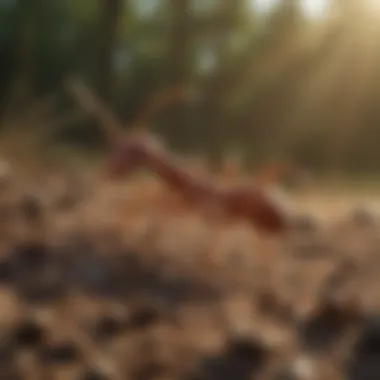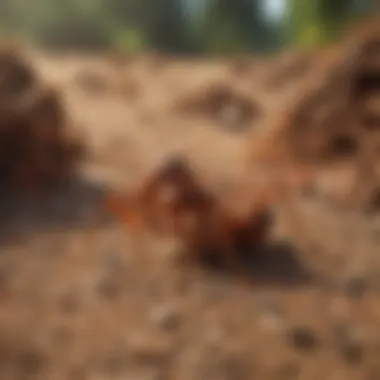Extinguishing Fire Ant Infestations: Control Guide


Preventive Pest Control Strategies
Preventive pest control is an essential approach for maintaining a pest-free home. Understanding and implementing effective strategies can significantly reduce the likelihood of fire ant infestations. The following sections elucidate various preventive measures that can be taken in and around the home to safeguard against these pests.
House Exterior Protection
Tips for sealing cracks
One of the most effective methods to keep fire ants from entering the house is by sealing any cracks or openings in the exterior of the home. This includes gaps around windows, doors, and the foundation. Using caulk or foam sealant can help create a barrier that prevents small pests from infiltrating your living space.
Clearing debris
Keeping the exterior of the house clean is crucial. Fire ants are attracted to clutter, so clear away any debris, leaves, or wood piles in close proximity to the home. Ensure that the yard is well-maintained and that no materials are left out that can serve as nests or hiding spots.
Preventing pests from entering
In addition to sealing cracks, it is wise to install door sweeps and screens on windows. This adds another layer of protection against insects and pests. Regularly inspect these areas to ensure they remain effective.
Yard Maintenance
Essential yard care routines
Maintaining a well-groomed yard is an essential part of pest prevention. Regular mowing, trimming hedges, and removing excess mulch can help discourage fire ants from setting up colonies in the yard. Aim to keep grass and plants at an optimal height to reduce hiding spots for pests.
Methods for keeping yard pest-free
Consider using barriers such as wood chips or diatomaceous earth around the perimeter of your garden beds. These can deter fire ants and many other pests. Additionally, applying beneficial nematodes in the soil can naturally reduce pest populations without harmful chemicals.
Indoor Cleanliness
Expert cleaning tips and techniques
Maintaining a clean indoor environment is critical. Regular sweeping and vacuuming can eliminate crumbs and food particles that attract pests. Ensure that pantry items are stored in tightly sealed containers.
Maintaining a pest-resistant indoor environment
Consider using airtight containers for food storage. Keeping the kitchen clutter-free and promptly cleaning up spills can significantly decrease the risk of attracting fire ants indoors.
Garbage Disposal
Efficient waste disposal methods
Proper garbage disposal is crucial to pest prevention. Use trash cans with tight-fitting lids and dispose of waste regularly. Ensure that recycling materials are rinsed out before disposal to minimize odors.
Importance of proper garbage disposal
By maintaining a routine waste disposal plan, homeowners can greatly reduce the likelihood of attracting fire ants and other pests that are drawn to easy food sources.
Other Pest Prevention Strategies
Innovative ways to safeguard your home
Install a barrier of gravel between the soil and the foundation of your home. This can make it harder for pests to cross into your living space. Another technique is to ensure that any outdoor lighting is installed away from doors to avoid attracting insects towards the entrance.
“Prevention is the best medicine when it comes to pest control.”
Understanding and implementing these preventive strategies can help manage fire ant risks effectively. Each effort contributes towards creating a more pest-resistant environment both indoors and outdoors.
Intro to Fire Ants
Understanding fire ants is essential for effective management and control. Many householders face issues from these pests, which can cause both economic damages and health risks. Fire ants are notorious for their painful stings, and their aggressive nature makes infestations particularly challenging. By gaining insight into their species, behaviors, and distribution, individuals and communities can better prepare and respond to fires ant issues.
Understanding Fire Ant Species
Fire ants belong to the genus Solenopsis, with several species affecting different regions. The most recognized species is the red imported fire ant, which is prevalent in the southern United States. The tropical fire ant is also a concern but is more localized. Fire ant species vary in behavior, with some being more aggressive than others. Understanding the specific species in your area can guide pest control measures. Moreover, recognizing distinct characteristics such as size, color, and mound construction can help in accurate identification.
The Global Distribution of Fire Ants
Fire ants are not just confined to the United States. They have spread to various parts of the world, affecting agriculture and local ecosystems. Initially from South America, they have migrated to North America, Australia, and some parts of Asia. Their ability to thrive in different environments contributes to their invasive nature. Areas with sandy soil and warm climates favor their nesting and breeding. Understanding where fire ants exist helps in strategizing effective control measures, as conditions in each region can influence the behavior and life cycle of these ants.


"Fire ants can spread rapidly, leading to significant challenges for management and control."
In summary, the introduction to fire ants lays the groundwork for understanding the implications of their presence and how best to deal with infestations. The knowledge gathered here enables homeowners to approach the problem with informed strategies aimed at prevention and extermination.
Biology and Behavior of Fire Ants
Understanding the biology and behavior of fire ants is crucial in developing effective strategies for their control. Their life cycle, social structure, and foraging habits are integral to their survival and proliferation. Knowledge of these elements allows individuals and communities to identify the most effective control methods. By grasping how fire ants live and interact, homeowners can anticipate patterns that lead to infestations. This section aims at providing a comprehensive overview of these important aspects, which are fundamental in the quest for effective fire ant management.
Life Cycle and Reproduction
Fire ants undergo a complete metamorphosis which includes four distinct stages: egg, larva, pupa, and adult. The life cycle begins when a queen lays eggs. The eggs hatch into larvae, which are then fed by worker ants. This nurturing phase is crucial for the development of the colony.
The queen can produce thousands of eggs per day, especially in favorable conditions. This prolific reproduction underlines why control measures must be vigilant and timely. Colony growth can quickly lead to an overwhelming infestation. Patience is required, as it may take weeks or even months to see results from control efforts, depending on the colony's size.
Key Points to Remember:
- Fire ant life cycle involves four stages.
- Queens have a high reproductive capacity.
- Control measures should be timely for effectiveness.
Nest Building and Colony Structure
Fire ant nests are often found in open areas, particularly in disturbed soils. The construction of these nests varies geographically, but generally, they feature a central mound. Mounds can be several feet wide and may have multiple entrances. The structure supports ventilation, temperature control, and protection for the colony.
Colony structure is hierarchical, comprising the queen(s), workers, and drones. The queen's primary role is reproduction, while workers are responsible for foraging, nest maintenance, and caring for the larvae. Understanding this structure aids in pinpointing the nest and directing control efforts effectively. For example, if the queen is eliminated, the colony’s growth declines significantly.
Nest Characteristics:
- Usually found in disturbed soils.
- Central mound with many entrances.
- Hierarchical organization supports survival.
Foraging Behavior and Food Preferences
Fire ants are opportunistic feeders, which means they forage for a wide range of food sources. Their diet includes proteins, carbohydrates, and fats. Common items they seek out include seeds, insects, and even human food. This adaptability in food choices contributes to their resilience in various environments.
Foraging tends to peak during warmer months. Ants leave pheromone trails, guiding other workers to food sources. Recognizing these trails can alert homeowners to active foraging behavior, signaling nearby nests. This is an opportunity to apply some control methods before the population expands.
Food Preferences:
- Seek proteins, carbohydrates, and fats.
- Adaptability aids survival.
- Pheromone trails signal food sources.
Understanding the biology and behavior of fire ants enables effective control strategies, helping to prevent infestations and protect residential areas.
The Impact of Fire Ant Infestations
Understanding the impact of fire ant infestations is essential to grasp the broader implications of these pests within our environment. Fire ants are not just a nuisance; they can have significant economic and health-related consequences. These impacts extend beyond immediate effects on gardens and lawns, affecting local economies, agriculture, and public health. Addressing fire ant infestations requires recognition of the wide-ranging effects they can cause.
Economic Consequences
Fire ant infestations can lead to substantial economic tolls. These ants can damage crops, disrupt farming activities, and tarnish the reputation of affected regions. Farmers in areas infested with fire ants often experience reduced crop yields. Fire ants will invade fields, attacking livestock and workers. This often results in lower productivity due to increased costs for pest control.
Moreover, there is an indirect cost connected to consumer behavior. People are less likely to visit businesses in areas where fire ants are prevalent. This can hinder local tourism and diminish property values. Further, the expenses incurred in the elimination of fire ants can be considerable. Many homeowners spend significant amounts on professional pest control services while others invest in chemical treatments and preventive measures.
Health Risks Associated with Fire Ants
The health risks posed by fire ants cannot be understated. Their painful sting can lead to allergic reactions in some individuals. In severe cases, these reactions can result in anaphylaxis, which is a life-threatening condition requiring immediate medical attention. Children and pets are particularly vulnerable to fire ant stings due to their size and fragile health.
In addition to immediate health risks, there are long-term implications of fire ant infestations. Areas with high fire ant activity may become breeding grounds for various other pests, further compromising the safety and comfort of residents. This creates a cycle of pest problems that can be difficult to manage and reduces the overall quality of life in affected areas.
"Fire ants pose greater threats than just property damage; their sting can have health implications that require serious attention."
In summary, recognizing the impact of fire ant infestations is integral to understanding the urgency of pest management. The economic consequences alone can strain local economies, while the health risks pose dangers to families, pets, and vulnerable populations. Therefore, tackling this problem effectively is imperative for safeguarding community well-being.
Signs of Fire Ant Infestation
Recognizing the signs of fire ant infestation is crucial to effective control and prevention. By identifying these signs early, homeowners can take immediate action to mitigate damage and reduce the potential for health risks associated with fire ants. Fire ants are not just a nuisance; their presence often indicates a more significant problem that could escalate if left unchecked.
Identifying Fire Ant Mounds
Fire ant mounds are the most visible sign of an infestation. These mounds are typically small to medium in size, resembling loose earth piles. They can range from six inches to two feet in diameter and may vary in shape depending on the soil type and environmental factors.
Mounds are often found in sunny areas, as fire ants prefer warm conditions. Identifying these mounds is essential for planning control strategies. Here are some characteristics of fire ant mounds:
- Iridescent Surface: The surface may appear shiny or polished, giving it a distinctive look.
- No Entrances: Unlike some other ant species, fire ants do not usually create visible holes in their mounds. Instead, they may have a smooth appearance.
- Aggressive Behavior: Approaching a mound can provoke aggressive behavior from the ants. They may swarm and bite if they feel threatened.


Being aware of these characteristics can help homeowners quickly spot an active fire ant mound. Early identification allows for more efficient response strategies.
Observing Ant Behavior
Another critical sign of fire ant infestation is their behavior. Observing fire ants can provide valuable insights into the severity of an infestation and the effectiveness of control measures.
When watching fire ants, consider the following behaviors:
- Foraging Patterns: Fire ants are diligent foragers. Their presence in large numbers, especially near food sources, can signal an infestation. If homeowners notice ants consistently near pet food, garden areas, or garbage, it may indicate a problem.
- Aggressive Defense: If disturbed, fire ants will defend their nest aggressively. This defensive behavior is often seen when someone unknowingly treads close to a mound.
- Presence of Winged Ants: During mating seasons, winged fire ants can be observed. Their presence indicates that the colony is reproducing and growing.
Observation of these behaviors helps in assessing the colony's activity and potential spread. Noticing these signs enables homeowners to take proactive measures before the situation escalates.
Methods of Fire Ant Control
The topic of fire ant control is crucial in managing infestations that can disrupt both personal and community spaces. Utilizing various methods of control allows for a multifaceted approach, leading to more effective eradication and long-term management. Understanding the methods available helps to select suitable techniques based on specific needs, environmental considerations, and infestation severity.
Chemical Control Options
Chemical control remains one of the primary strategies for combating fire ant infestations. Using insecticides can rapidly decrease ant populations, providing immediate relief. Understanding the types of insecticides, application techniques, and safety considerations is key to successful implementation.
Types of Insecticides
Insecticides can be classified into several categories, including contact insecticides, residual insecticides, and baits. Each type has its role in pest control.
Contact insecticides work quickly on contact with the ants, leading to immediate knockdown. Residual insecticides remain active on surfaces for longer periods, allowing for sustained control. Baits attract worker ants, which carry the poison back to their colony, targeting the queen and reducing the entire population.
The key characteristic of insecticides is their efficacy in eliminating ants swiftly. They are beneficial because they offer immediate results in tackling visible infestations. However, it is crucial to consider their potential side effects on non-target species and the environment. Often, they can be harmful to beneficial insects, so selective application is necessary.
Application Techniques
The method of application significantly affects the success of chemical control. Techniques may vary based on the type of insecticide used and the specific area being treated. Common application methods include granules, sprays, and bait stations.
Granules are often used in soil treatments, while sprays are suitable for direct applications on mounds. Bait stations provide a slow-acting solution that allows ants to feed and distribute the insecticide throughout their colony.
Proper application techniques enhance the overall effectiveness of insecticides. They ensure that the chemicals reach the target areas efficiently, minimizing waste and environmental harm. However, incorrect techniques can lead to ineffective treatments. Careful consideration of weather conditions and terrain is important for optimal application.
Safety Considerations
Safety is paramount when applying chemical controls. Ensuring the wellbeing of people, pets, and the ecosystem is vital. Many insecticides come with specific instructions for safe handling and application, which should always be strictly followed.
The key safety consideration is the need to use proper protective gear during handling to avoid skin contact and inhalation. In some cases, insecticides may pose risks to aquatic life, so specific care must be taken near water sources.
Being informed about potential side effects and adhering to safety protocols can create a balanced approach to pest control without sacrificing health. Over-reliance on chemicals can result in resistant fire ant populations, making diverse approaches critical.
Biological Control Approaches
Biological control offers a more eco-friendly alternative to manage fire ant populations. By introducing their natural predators or pathogens, one can effectively reduce fire ant numbers.
Natural Predators
Natural predators, including certain bird species, other ant species, and even nematodes, can control fire ants effectively. Their presence can suppress fire ant populations naturally over time.
The key characteristic of natural predators is their ability to provide a sustainable solution to pest management. They can be beneficial for long-term control as they establish a balanced ecosystem without the need for harsh chemicals. However, a clear understanding of the predator-prey dynamics is essential to ensure the introduction of the right species to the area.
Pathogens and Parasitism
Pathogens and parasitic organisms can also contribute to controlling fire ant infestations. Certain fungi and nematodes specifically target fire ant colonies. Upon infection, these pathogens can decimate levels within colonies, leading to significant population decline.
The unique feature of these biological control agents is their minimal impact on non-target species. They serve as a natural way to suppress fire ant populations while promoting biodiversity. However, results may take longer to manifest compared to chemical methods, so patience is required.
Cultural Control Strategies
Cultural control strategies are proactive approaches designed to create unfavorable conditions for fire ants. Tackling these pests preemptively can lead to healthier, pest-free environments.
Sanitation Practices
Maintaining cleanliness in and around the home can help in controlling fire ants. This includes managing waste, food sources, and eliminating potential nesting sites, such as debris or wood piles.
The main advantage of sanitation practices is that they complement other methods of control, making them a fundamental step in any pest management plan. They reduce attractants and nesting opportunities for fire ants. However, consistent effort is required to observe significant results.


Landscaping Techniques
Landscaping can influence the likelihood of fire ant infestations. Certain landscaping techniques can reduce nesting opportunities. For example, using organic mulch can create conditions that deter fire ants.
The primary benefit of appropriate landscaping is its effectiveness in modifying the environment to disallow colony establishment. Implementing these techniques can provide a long-term strategy against pest infestations. However, understanding the static nature of landscaping changes is essential. Results may not be immediate, and a thorough plan is needed for sustained success.
Integrated Pest Management Solutions
Integrated Pest Management (IPM) is a comprehensive approach. It focuses on fire ant control by combining various strategies. This method considers the specific needs of the environment while addressing pest infestations effectively. IPM is critical in the discussion about fire ant management as it provides sustainable solutions, unlike traditional methods that may have negative ecological or health implications.
Importance of IPM in Fire Ant Control
IPM encompasses several key elements:
- Prevention: It emphasizes preventing infestations before they occur. This is achieved through good practices in landscaping and sanitation.
- Monitoring: It involves ongoing assessments to determine the presence of fire ants. This data informs the need for intervention.
- Control measures: IPM incorporates a mix of chemical, biological, and cultural controls tailored for the specific situation. Thus, it minimizes potential harm to the environment and human health.
By focusing on such a multifaceted approach, IPM offers numerous benefits.
Enhancing sustainability: Managing fire ant populations sustainably reduces reliance on harsh chemicals.
Resilience against infestations: A well-structured IPM plan enables quicker and more effective responses to infestations, minimizing damage.
Developing an IPM Plan
Creating an effective IPM plan for fire ant control involves several steps:
- Assessment of the problem: Understand the extent of the infestation. This may require identifying fire ant species, their nests, and overall activity in the area.
- Setting objectives: Clear objectives must be established. For example, the goal may focus on reducing fire ant populations or protecting specific areas.
- Selecting control options: Identify the appropriate combination of control measures based on the assessed problem. Consider chemical, biological, and cultural options available. It is important to choose solutions that align with environmental safety and community health concerns.
- Implementation: Execute the plan efficiently. Ensure that all individuals involved understand their roles and responsibilities.
- Review regularly: Adjust the plan based on ongoing observations and monitoring results.
Monitoring and Evaluation
Effective IPM requires regular monitoring and evaluation. This ensures that control measures are working as intended. Here are key elements:
- Regular inspections: Frequent checking for fire ant mounds or changes in activity will help gauge effectiveness.
- Data collection: Documenting findings aids in understanding trends and patterns. It also facilitates future planning.
- Adjustments: Based on monitoring, the IPM plan might need adaptation. If specific control measures are ineffective, alternatives can be explored quickly.
"Ongoing monitoring ensures that you stay ahead of fire ant infestations, allowing for timely interventions."
This comprehensive approach fosters a deeper understanding of fire ant management while minimizing risks associated with pest control practices. By implementing IPM strategies, homeowners can tackle fire ant problems effectively and more sustainably.
Preventive Measures Against Fire Ants
The prevention of fire ant infestations is critical for maintaining a safe and healthy environment. This proactive approach can save property owners significant time and resources, as managing infestations after they occur can be both challenging and costly. Understanding how to deter fire ants before they establish colonies serves as a first line of defense.
Environmental Management
Adjusting Soil Conditions
Soil conditions play a significant role in the habitat suitability for fire ants. These pests prefer well-aerated sandy soils where they can easily dig their mounds. By changing soil compaction levels and moisture, homeowners can create an environment that is less conducive to fire ant establishment.
A key characteristic of adjusting soil conditions involves amending the soil with organic matter. This practice not only improves soil texture but also increases drainage. As fire ants prefer areas with abundant moisture, dry soil conditions may deter them effectively. This method is a beneficial choice, as it not only targets fire ant infestations but also promotes healthier garden and lawn growth.
On the downside, altering soil conditions might require ongoing effort. Regular monitoring and amendment may be needed to maintain unfavorable conditions for fire ants. Keep in mind that while adjusting soil can help, it should be part of a broader strategy.
Reducing Standing Water
Standing water can be an attractive element for fire ants. These insects are known to create nests near water sources. Reducing standing water not only limits watering access for fire ants but also decreases the overall moisture levels in the surrounding soil. This is an effective step that may have immediate results.
One key characteristic of reducing standing water is the implementation of efficient drainage solutions. Properly grading your yard or installing drainage tiles can ensure that water does not accumulate. This solution helps in deterring fire ants from taking up residence nearby, making it an exceedingly popular tactic in fire ant prevention.
While the benefits are clear, there are unique features to consider. If drainage systems are not maintained properly, they can become breeding grounds for mosquitoes and other pests. Therefore, while effective in controlling fire ants, it is crucial to adopt sustainable and managed practices.
Community Involvement
Community involvement can play an essential role in combatting fire ant infestations. When neighbors work together, the effectiveness of control measures can increase significantly. Educating local communities about fire ants and best practices can lead to broader participation in preventative efforts.
Encouraging neighborhood clean-up events can help manage habitats that fire ants favor. Also, promoting awareness about regular monitoring and reporting of any signs of infestations can be highly beneficial. By fostering community engagement, the impact of fire ants can be reduced across larger areas, ultimately protecting homes and local ecosystems.
The End
The conclusion of this comprehensive guide serves a crucial purpose in encapsulating the entire discussion on fire ant control. Summarizing effective strategies not only reinforces the key points presented throughout the article but also highlights the importance of a multi-faceted approach to managing fire ant infestations. These pests pose significant threats to both ecosystems and human health, and thus, understanding both the biological traits of fire ants and the implications of their presence is essential for effective control.
Summarizing Effective Fire Ant Control
Effective fire ant control requires the integration of various methods. Chemical options, such as targeted insecticides, play a vital role but must be applied judiciously to mitigate potential harm to the environment and non-target species. Biological control, utilizing natural predators and parasites, offers sustainable solutions but needs careful monitoring to ensure efficacy. Cultural practices, like improved sanitation and strategic landscaping, create an environment less hospitable to fire ants. These elements work synergistically to provide a robust strategy for management.
"An integrated approach not only directs efforts towards immediate extermination but also fosters long-term prevention."
Households should undertake regular monitoring and evaluation of control measures. Establishing a preventive mindset can significantly reduce the chances of severe infestations in the future. Continuous education about the biology and behavior of fire ants is also essential for adapting strategies that align with individual household needs.
Future Research Directions
Looking ahead, research into fire ant management should focus on several key areas. There is a pressing need for studies that evaluate the long-term effects of various control methods on non-target species and the environment. Additionally, developing innovative, eco-friendly insecticides promises a safe alternative for households wary of chemical solutions. Such options not only cater to environmental concerns but can also appeal to community standards regarding safety.
Understanding the genetic factors influencing fire ant behavior and resistance to control measures represents another avenue for future research. Advances in genetic analysis may lead to targeted control methodologies, enhancing the effectiveness of existing strategies.



